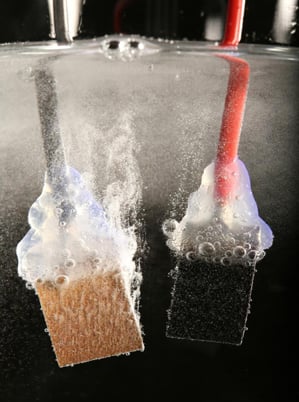A Promising Step Toward Round-the-Clock Solar Power
If solar power is to become a primary source of electricity around the world, we’ll need cheap ways to store energy from the sun when it isn’t shining. A paper published in the journal Science this week reports a major step toward such a system. Researchers have developed a device that cheaply and efficiently converts the energy in sunlight into hydrogen, which can be used as a fuel and is easily stored.

Michael Graetzel, who directs the Laboratory of Photonics and Interfaces at the Ecole Polytechnique in Lausanne, Switzerland, along with colleagues in Korea and Singapore, built a device that uses electricity and catalyst materials to make hydrogen and oxygen from water. This new “water splitter,” as such devices are known, is highly efficient, uses cheap and abundant materials, and is easy to make.
Researchers have been pursuing solar-powered water splitting for decades, and while they’ve shown great performance in one or two parts of such a device, no one has built a complete system that’s practical.
The new device is remarkable because it meets three of the four criteria needed for a practical device: high efficiency, low cost, and the use of abundant materials (so it can be used at a large scale). The next step is to meet the fourth criterion—reliability. The device uses novel, relatively high-voltage solar cells to generate the needed electricity, along with inexpensive new catalyst materials based on nickel and iron for two electrodes—one produces hydrogen and the other makes oxygen.
The catalysts built on previous work showing that nickel hydroxide is a promising catalyst, and that adding iron could improve it. The researchers added iron to nickel hydroxide to form a layered structure, and put the catalyst on a porous nickel “foam” to increase the area across which reactions can take place, speeding them up.
The solar cells use an inexpensive and easily manufactured material known as perovskite, which has been generating excitement in the research community because efficiencies have been improving at a breakneck pace over the last few years (see “A Material That Could Make Solar Power ‘Dirt Cheap’” and “Controlled Crystals Make a New Solar Material Practical”).
The solar water splitter stores 12.3 percent of the energy in sunlight in the form of hydrogen. That might seem like a small amount, but consider that most solar cells convert only 16 percent of the energy in sunlight into electricity, without the added step of turning that energy into easy-to-store hydrogen.
More work is needed before the device can be practical. For one thing, it only lasts a few hours before the solar cell performance quickly drops off. Researchers aren’t sure why perovskite materials degrade quickly, but they’ve been making progress—such as by adding a layer of carbon or improving the way the solar cells are sealed against the elements. Researchers recently demonstrated a perovskite solar cell that lasted over a month.
Keep Reading
Most Popular
Large language models can do jaw-dropping things. But nobody knows exactly why.
And that's a problem. Figuring it out is one of the biggest scientific puzzles of our time and a crucial step towards controlling more powerful future models.
The problem with plug-in hybrids? Their drivers.
Plug-in hybrids are often sold as a transition to EVs, but new data from Europe shows we’re still underestimating the emissions they produce.
Google DeepMind’s new generative model makes Super Mario–like games from scratch
Genie learns how to control games by watching hours and hours of video. It could help train next-gen robots too.
How scientists traced a mysterious covid case back to six toilets
When wastewater surveillance turns into a hunt for a single infected individual, the ethics get tricky.
Stay connected
Get the latest updates from
MIT Technology Review
Discover special offers, top stories, upcoming events, and more.